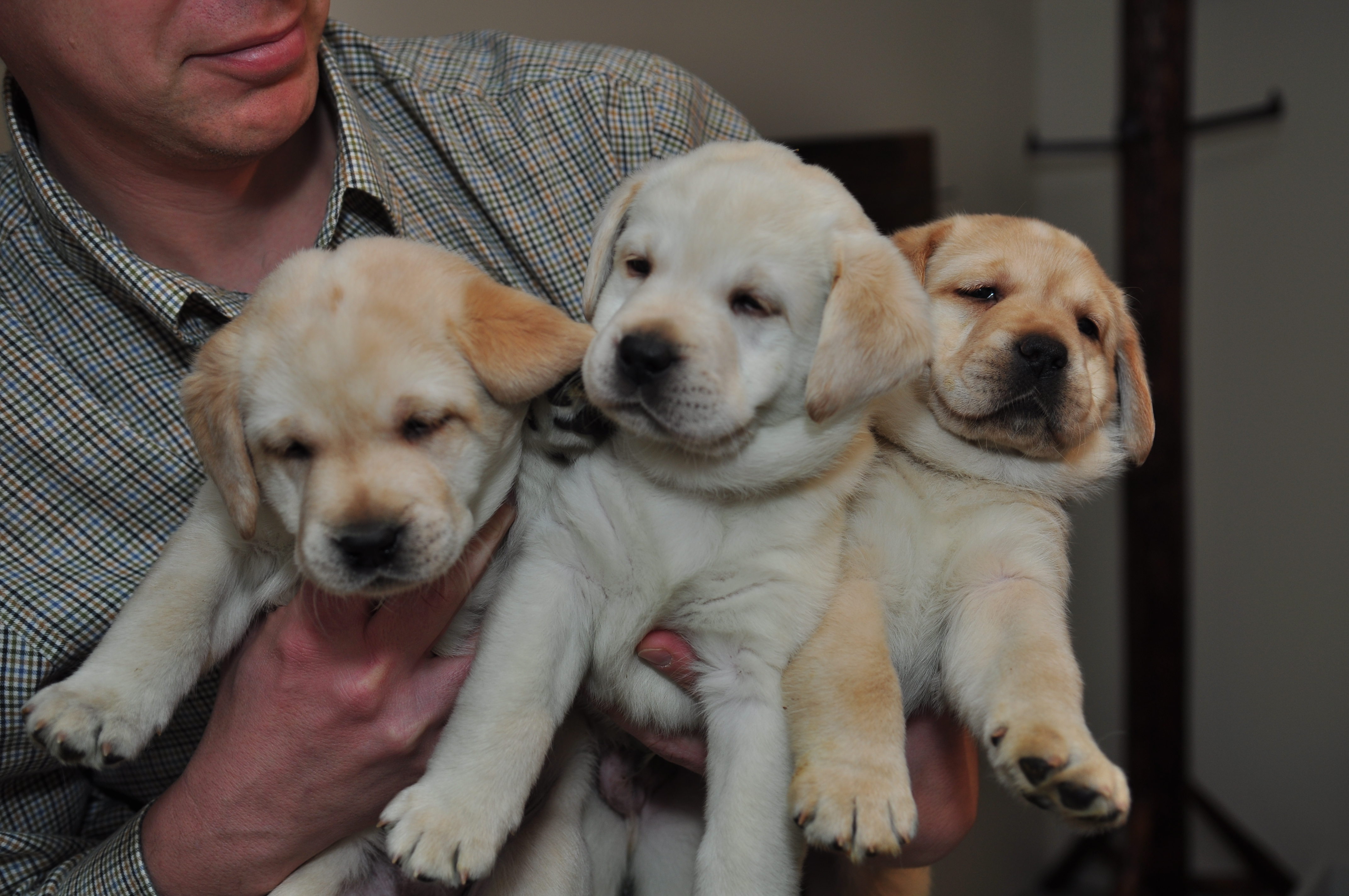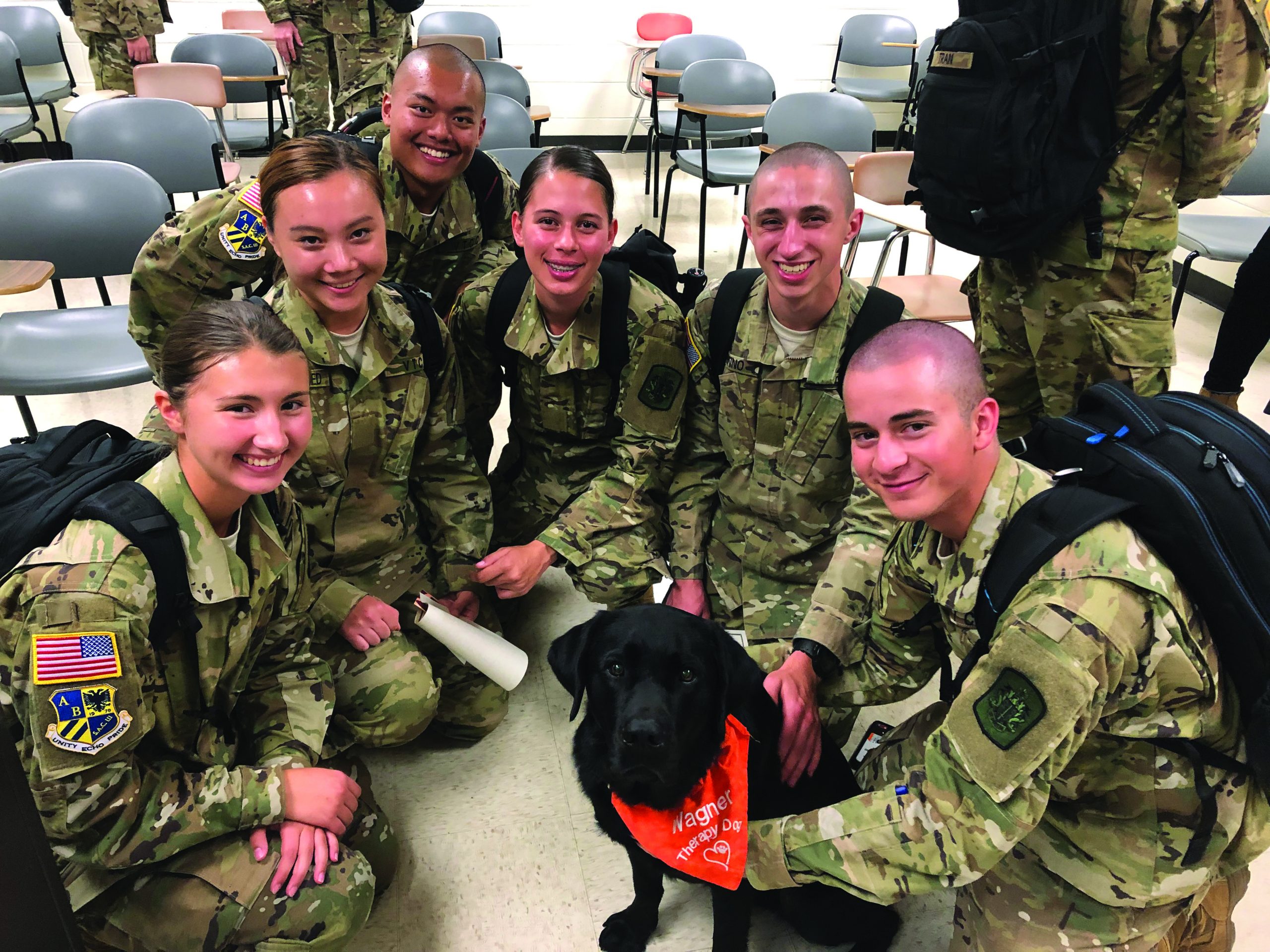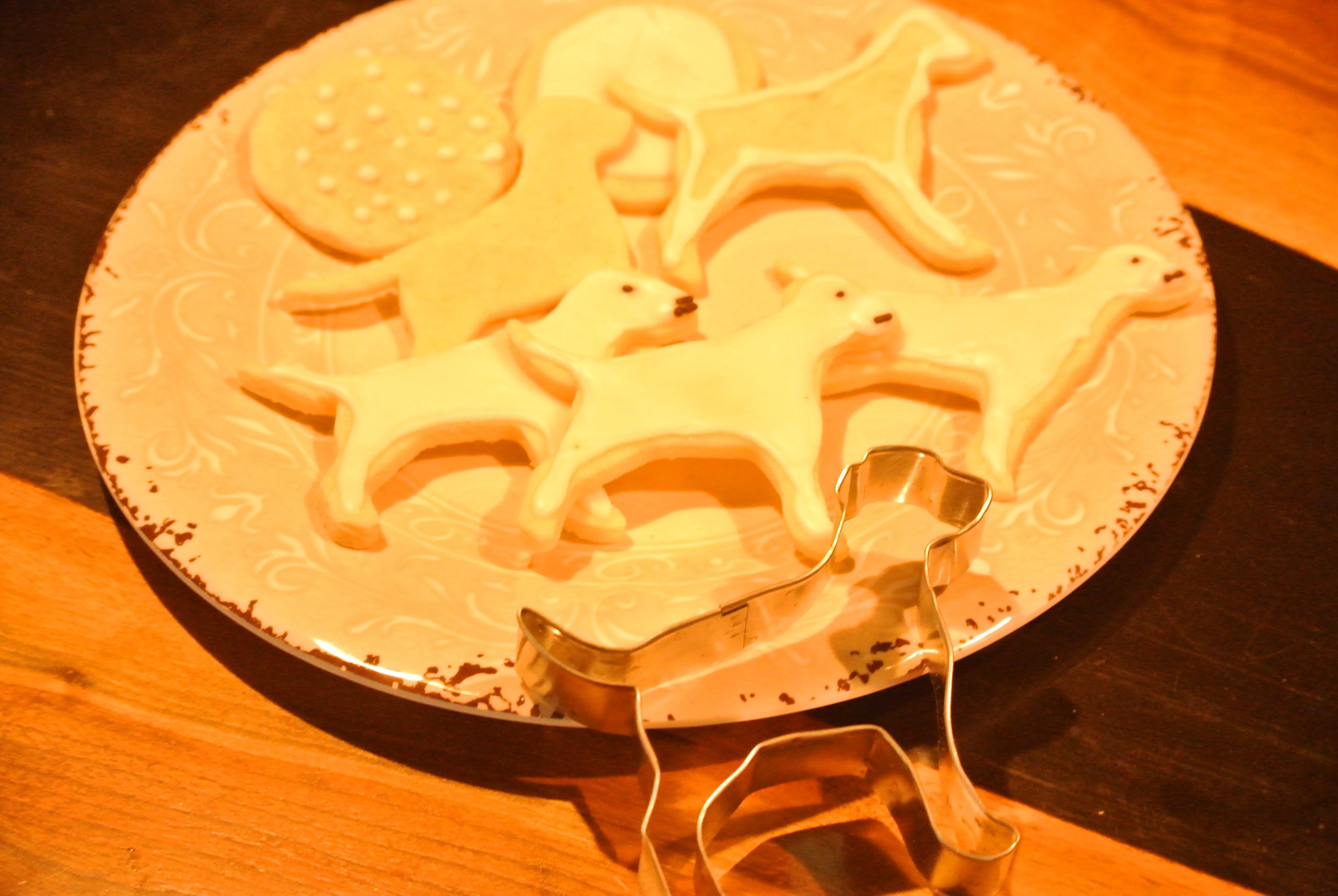by Jason Smith
Vickie and George Strait.
It took both of them to help Cici. After petting her from outside the whelping box for several hours, my wife finally got inside with her; and, with George Strait on the radio, Cici mashed her head into Vickie, pinning her down as the contractions finally intensified. Another hour later, and with her typical calm and collectedness, Vickie announced in a soothing, sing-songy voice, to help keep Cici relaxed, “Well, there’s a puppy!”
Pete, our 12-year-old son, who was there with us, looked at me. We had the same thought: Nah. And we went back trying to load up a missed episode of one our favorite shows through my computer.
“Uh, guys…” Vickie said, still serene, still composed.
Pete and I, by this point, were freaking out.
And just like that, one little Labrador girl came into the house. Over the course of the next few hours, five more joined her – two more females, and three males.
We found out firsthand what Sam Ziegenmeyer, Leader Dogs for the Blind’s Breeding Program Manager (LDB, www.leaderdogs.org) had told me about the most difficult thing breeder-host families experience: “Patience is the hardest thing for host families. Whelping a litter of puppies is a process. It takes its own sweet time and cannot be rushed. Nature provides this miracle every day over and over again. Of course, it is difficult when a puppy does not make it through the birthing process, but it is quickly overshadowed by the next puppy that appears. The reward is seeing the whole litter happily nursing after they have all been born. Then rewards keep coming as the eyes and ears open, they start toddling, the first barks, and you see them learning lessons as they grow.”
 And, oh, what rewards. So much so that Mark, our 10-year-old, firmly declared two weeks ahead of time that December 2nd would be the worst day of his life. That’s the day the pups return to LDB. And with the pictures seven-year-old Maddie keeps drawing of the puppies and the library books she checks out on how to take care of puppies and the evening snuggles with the puppies on the floor and the couch? Oh boy. December 2nd is going to be a long day.
And, oh, what rewards. So much so that Mark, our 10-year-old, firmly declared two weeks ahead of time that December 2nd would be the worst day of his life. That’s the day the pups return to LDB. And with the pictures seven-year-old Maddie keeps drawing of the puppies and the library books she checks out on how to take care of puppies and the evening snuggles with the puppies on the floor and the couch? Oh boy. December 2nd is going to be a long day.
Vickie’s calm demeanor at the birth of that first little female kept up through the whole night and the next day, even though the whole process is, frankly, a little gross. But it is nature in action, with Cici nibbling away at the sac the puppy comes in, devouring the sac and the placenta for a boost of nutrition, and licking the pup vigorously. Vickie dove right in to help, rubbing each puppy briskly with a towel when necessary until those first tiny cries as the mucous clears from their mouths. Then, setting them down next to Cici, we stood in total amazement as, only a minute old, they belly-crawled right to Momma for immediate nursing. All the while, I recorded data on time of birth, weight, sex, the presence of dewclaws, cleft palates, and other measurements.
I was just fine with the clipboard, thank you very much. Vickie did such an excellent job with the, uh, business end of things, I didn’t want to interrupt.
Between pups, Cici devoured scoops of vanilla ice cream for an added sugar boost and energy. She didn’t like the first couple of spoonfuls too much, but she soon started anticipating it – it was so clear to see, as each pup emerged, her relief. And as nature continued with each birth, nature continued on in Cici as well. Such an amazing mom.
To see her deal with all of the messes, licking the pups to stimulate their going to the bathroom, perking her ears at each little yip… for those first couple of days, Vickie and I were there to feed Cici (a lot, like 10-cups-of-food-a-day a lot) and to wash blankets and towels. She took care of everything. “Host families stand watch to make sure that mom and puppies progress through the whelp and alert Leader Dog at the first sign of trouble,” Ziegenmeyer says. “They help as needed to provide mom and puppies with as natural-as-possible whelp with a successful outcome.”
LDB, and our breeding specialist Stacey Booms, as well as the LDB on-call vet, were available every step of the way, too. In addition to the whelping box, scale, milk replacement, some medications, a heat lamp, an exercise pen, and several other supplies they provided us when we picked up Cici after her being bred, the single most important thing they sent us home with was the “breeding bible.” Unbelievable, how often we consulted it, and how accurate it was in what to expect and when, how to deal with certain things, and what to be on the lookout for. In addition, we had our mentor available for phone consultation should we have needed it. Helping Cici and LDB in the process of bringing tomorrow’s leaders into the world is certainly a team sport.
For the first two weeks, Vickie and I took turns sleeping on an air mattress by the whelping box. Call it new dog-grandparent paranoia: We just wanted to make sure that Cici fed them and didn’t step on any of them. When her milk came in and they lined up at the trough, nursing in a state of puppy bliss, those first two weeks saw a lot of growth as the six pups – who we named Pearl, Pixie, Buster, Yelsa, Olaf, and Reggie, corresponding to their colored ribbons of purple, pink, blue, yellow, orange, and red – went from right around one pound to more than three. After one week, their scrunched noses and smooth pads changed from raw-skin pink to black.

As Ziegenmeyer said, the rewards kept coming. First barks. Seeing them play. Seeing them wag when we stick our heads over the box or pick them up. Perhaps the most precious: those first squints as their eyes worked open.
And then, just like any of the Labradors in our homes right now, to have a little dog staring at you, reading you, at four weeks old… absolutely amazing.
Stimulation and socialization are key for any puppy, but for those dogs destined to the world of service, the sooner these can begin, the better. For the “average” Labrador, though, it is equally important, and as you look for that next puppy, it might be a good question to ask a breeder when you are considering getting one of their pups: How much stimulation and socialization have the pups been getting from the very beginning?
Take a look at the accompanying sidebar for the description of the regimented “puppy stimulation exercises” LDB asked us to perform with each dog. It might not seem like much, but it has an impact.
Once these initial exercises were completed and the pups were moving around more, eyes open and wagging, the stimulation came in the form of people contact. Lots of people contact. Individually, we’d take them into a bedroom where it was carpeted and get right down and play, make noises, let them explore and run and waddle and fall over and run some more, all the things puppies need to do. That’s where I found out that, yes, in fact their teeth had come in, when Reggie wriggled under my arms, wormed his way up, and chomped on my ear.
(An aside: all young mammals need to move and play and use their gross – big – motor muscles; such movement has been found to stimulate the development of neural pathways in the brain. Many educators are now advocating three to five recesses a day for young schoolchildren.)
These individual times began to show their personalities, too. Buster put his nose on the ground and sniffed and explored, oblivious to my claps and floor taps, intent on figuring everything out. Pearl did the same, but with more caution. Yelsa sat down and yapped and had an altogether haughty look, the experience beneath her. And Olaf, Pixie, and Reggie just flat out played with us. They followed us everywhere, crawled over legs and arms and hands, bit, licked, tugged, barked, and wagged constantly.
Another new experience at around the four-week mark: food. That smelly puppy mash was absolute heaven for them the very first time they tasted it. Yeah, they’re Labs all right.
But the LDB rules also start right away, too. In particular, making sure they do their best to sit before any interaction them, whether it’s picking them up, playing with them, or feeding them. Ziegenmeyer feels that’s one of the most crucial things a host family can do: “Puppies born in our program are bred and raised with this purpose [being a Leader Dog] in mind. Keeping that purpose in mind as puppies are handled makes the difference between having raisers start with a pet puppy that needs to learn manners, and a future Leader Dog that is ready to continue with training. Teaching the self-control exercise of sitting for every interaction provides a life skill other dogs may never learn.”
It’s such a riot to be standing by the whelping box and watching the melee for attention when, all of a sudden, one of the pups will stop, look at me very seriously, and then sit on his or her own. That’s the one I then reach down and pick up for some cuddle time.
With these daily interactions and adjusting to life with eight Labradors in the house, the days, as they so often do, slipped by. It was time to start thinking of the journey back to LDB to drop them off, a date already established before they were even born. “We will schedule an appointment, within days of their birth, for the litter’s return,” says Ziegenmeyer. “This is so we can start making arrangements for their next stage in their journey. We will be calling raisers and setting up appointments for them to pick up their next puppy. Raisers will start getting weekly e-mails the week before getting the puppy.
These will continue through sixteen weeks, offering the raisers a curriculum to get the best start with their future Leader Dog.” We’ve been preparing a packet of photos to go back with each pup, too.
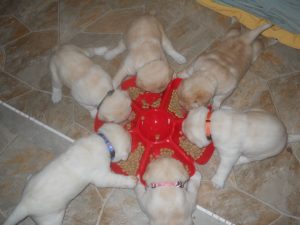 When the puppies arrive back at the facility, LDB is ready. “Many steps along the way are scheduled for the puppies so they can be prepared to go to their puppy raisers,” Ziegenmeyer says. “Each litter goes through a physical, vaccines, deworming, microchipping, and a bath before going to their raisers. We break these up over the few days they are with us so we don’t stress the puppies too much. These few days also allow us time for Puppy Development to confirm appointments, assess the litter, create raiser packets, and allow the dad’s host home to meet the litter.” Cici will also get a work-over at that time before loading back up in the car and coming home.
When the puppies arrive back at the facility, LDB is ready. “Many steps along the way are scheduled for the puppies so they can be prepared to go to their puppy raisers,” Ziegenmeyer says. “Each litter goes through a physical, vaccines, deworming, microchipping, and a bath before going to their raisers. We break these up over the few days they are with us so we don’t stress the puppies too much. These few days also allow us time for Puppy Development to confirm appointments, assess the litter, create raiser packets, and allow the dad’s host home to meet the litter.” Cici will also get a work-over at that time before loading back up in the car and coming home.
It’s funny – the first signs that Cici was starting to feel back to her old self, a couple of days after the births. I was brushing my teeth, getting ready for bed, and I heard a snort. I looked out into our bedroom our room, and there’s Cici, sniffing around. She scooped up one Nylabone rubber ball, stuffed in a Kong bone alongside, looked at me and smiled and wagged, and then shuffled back downstairs to take care of her pups.
And now, as I write this just before Thanksgiving, she pretty much hangs out with us and plays with Ginny like normal, only a week away from taking the pups back to the LDB facility, from Mark’s “worst day of his life.” I’m sure we’ll have lots of tears. But three more litters are in store for us, and what comforts me is knowing that Cici will be coming home with us.
While we were in the midst of puppy mayhem, we received a letter from Leader Dogs for the Blind along with a couple of photos. One of the stately yellow Labs looked an awful lot like Cici. Sure enough, this letter was an update on Cici’s very first litter. Two of her puppies went on to become Leader Dogs, one for someone in the South, another for someone in a different country. We also learned how and why some of the others didn’t complete the training. “Each dog has its own success rate, as well as each breed,” says Ziegenmeyer, “but if we base Cici’s success rate on the average of her breed, we would expect 58 percent of her puppies to become working Leader Dogs.”
Looking at the six pups scampering around right now, I can’t help but wonder which ones will someday change a life.
Early Neurological Stimulation Exercises (Bio-Sensor Method)
Reprinted with permission from the Leader Dogs for the Blind Home Host Handbook; information provided by the U.S. Military
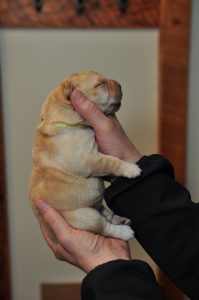 The U.S. Military, in an effort to improve the performance of dogs used for military purposes, developed the “Bio-Sensor” program. Based on years of research, they learned that early neurological stimulation exercises could have important and lasting effects. Their studies confirmed that there are specific time periods early in life when early neurological stimulation has optimum results.
The U.S. Military, in an effort to improve the performance of dogs used for military purposes, developed the “Bio-Sensor” program. Based on years of research, they learned that early neurological stimulation exercises could have important and lasting effects. Their studies confirmed that there are specific time periods early in life when early neurological stimulation has optimum results.
An immature puppy can be defined as being between 3-16 days of age. At this early age, most puppies can only suck, crawl, smell, and have limited vision. They cannot maintain their body temperature or digest food without help. They are unable to shiver, or urinate or defecate without stimulation from their mom. Their body temperature is subnormal, and their heart rate at birth is approximately 200 beats per minute. Early life is also a time when their body weight will double in 7-10 days.
It is believed that this interval of time (3-16 days old) is a period of rapid neurological growth and development.
In learning tests, stimulated puppies were found to be more active and were more exploratory than their non-stimulated littermates. Stimulated puppies also dominated in competitive situations.
In simple problem solving tests using detours in a maze, the non-stimulated puppies became extremely aroused, whined a great deal, and made many errors. Their stimulated littermates were less upset by test conditions, and when comparisons were made, the stimulated littermates were calmer in the test environment, made fewer errors, and gave only an occasional distress sound when stressed.
The “Bio-Sensor” program involves early neurological stimulation exercises in order to give the dog a superior advantage. Five exercises were designed to stimulate the neurological system. In a specific order, the handler starts with one puppy and stimulates it for 3-5 seconds using each of the five exercises before moving to the next puppy. The exercises are done daily for 14 days, starting when the puppies are three days old through 16 days old.
The five exercises will produce neurological stimulations that do not naturally occur during this early period of life. Experience shows that some puppies will resist these exercises, while others will appear unconcerned. Do not do them more than once per day and do not extend the time beyond that recommended for each exercise (3-5 seconds). Overstimulation of the neurological system can have adverse and detrimental results. These exercises impact the neurological system by kicking it into action earlier than would be normally expected, resulting in an increased capacity that later will help improve its performance. You should continue to play with your puppies and routinely handle them because the neurological exercises are not substitutions for routine handling, play socialization or bonding.
Benefits of Stimulation
• Improved cardio vascular performance (heart rate)
• Stronger heart beats
• Stronger adrenal glands
• Increased tolerance to stress
• Greater resistance to disease
Early Neurological Stimulation Exercises
1. Tactical Stimulation (between toes): Holding the puppy in one hand, gently stimulate (tickle) the puppy between the toes on any one foot using a Q-tip for 3-5 seconds only. It is not necessary to see that the puppy is feeling the tickle.
2. Head Held Erect: Using both hands, hold the puppy perpendicular to the ground (straight up), so that its head is directly above its tail for 3-5 seconds only. This is an upwards position.
3. Head Pointed Down: Holding the puppy firmly with both hands, hold the puppy perpendicular to the ground (straight down), so that its tail is directly above its head for 3-5 seconds only.
4. Supine Position: Hold the puppy so that its back is resting in the palm of both hands with its muzzle facing the ceiling for 3-5 seconds only. The puppy, while on its back, is allowed to sleep.
5. Thermal Stimulation: Using a damp towel that has been cooled in a refrigerator for at least five minutes, place the puppy on the towel, feet down for 2-5 seconds only. Do not restrain it from moving.

